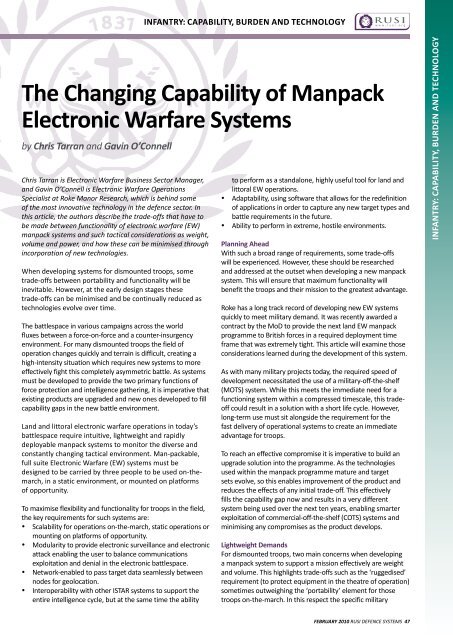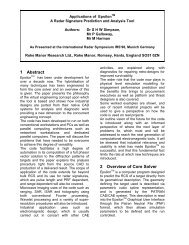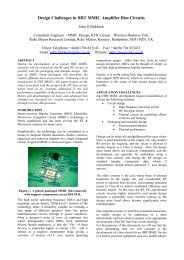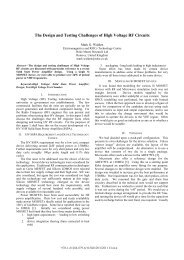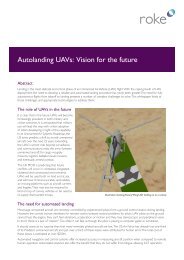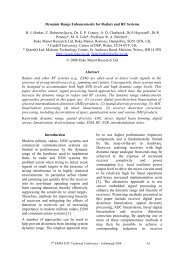The Changing Capability of Manpack Electronic Warfare Systems
The Changing Capability of Manpack Electronic Warfare Systems
The Changing Capability of Manpack Electronic Warfare Systems
Create successful ePaper yourself
Turn your PDF publications into a flip-book with our unique Google optimized e-Paper software.
Infantry: <strong>Capability</strong>, Burden and Technology<br />
<strong>The</strong> <strong>Changing</strong> <strong>Capability</strong> <strong>of</strong> <strong>Manpack</strong><br />
<strong>Electronic</strong> <strong>Warfare</strong> <strong>Systems</strong><br />
by Chris Tarran and Gavin O’Connell<br />
Chris Tarran is <strong>Electronic</strong> <strong>Warfare</strong> Business Sector Manager,<br />
and Gavin O’Connell is <strong>Electronic</strong> <strong>Warfare</strong> Operations<br />
Specialist at Roke Manor Research, which is behind some<br />
<strong>of</strong> the most innovative technology in the defence sector. In<br />
this article, the authors describe the trade-<strong>of</strong>fs that have to<br />
be made between functionality <strong>of</strong> electronic warfare (EW)<br />
manpack systems and such tactical considerations as weight,<br />
volume and power, and how these can be minimised through<br />
incorporation <strong>of</strong> new technologies.<br />
When developing systems for dismounted troops, some<br />
trade-<strong>of</strong>fs between portability and functionality will be<br />
inevitable. However, at the early design stages these<br />
trade-<strong>of</strong>fs can be minimised and be continually reduced as<br />
technologies evolve over time.<br />
<strong>The</strong> battlespace in various campaigns across the world<br />
fluxes between a force-on-force and a counter-insurgency<br />
environment. For many dismounted troops the field <strong>of</strong><br />
operation changes quickly and terrain is difficult, creating a<br />
high-intensity situation which requires new systems to more<br />
effectively fight this completely asymmetric battle. As systems<br />
must be developed to provide the two primary functions <strong>of</strong><br />
force protection and intelligence gathering, it is imperative that<br />
existing products are upgraded and new ones developed to fill<br />
capability gaps in the new battle environment.<br />
Land and littoral electronic warfare operations in today’s<br />
battlespace require intuitive, lightweight and rapidly<br />
deployable manpack systems to monitor the diverse and<br />
constantly changing tactical environment. Man-packable,<br />
full suite <strong>Electronic</strong> <strong>Warfare</strong> (EW) systems must be<br />
designed to be carried by three people to be used on-themarch,<br />
in a static environment, or mounted on platforms<br />
<strong>of</strong> opportunity.<br />
To maximise flexibility and functionality for troops in the field,<br />
the key requirements for such systems are:<br />
• Scalability for operations on-the-march, static operations or<br />
mounting on platforms <strong>of</strong> opportunity.<br />
• Modularity to provide electronic surveillance and electronic<br />
attack enabling the user to balance communications<br />
exploitation and denial in the electronic battlespace.<br />
• Network-enabled to pass target data seamlessly between<br />
nodes for geolocation.<br />
• Interoperability with other ISTAR systems to support the<br />
entire intelligence cycle, but at the same time the ability<br />
to perform as a standalone, highly useful tool for land and<br />
littoral EW operations.<br />
• Adaptability, using s<strong>of</strong>tware that allows for the redefinition<br />
<strong>of</strong> applications in order to capture any new target types and<br />
battle requirements in the future.<br />
• Ability to perform in extreme, hostile environments.<br />
Planning Ahead<br />
With such a broad range <strong>of</strong> requirements, some trade-<strong>of</strong>fs<br />
will be experienced. However, these should be researched<br />
and addressed at the outset when developing a new manpack<br />
system. This will ensure that maximum functionality will<br />
benefit the troops and their mission to the greatest advantage.<br />
Roke has a long track record <strong>of</strong> developing new EW systems<br />
quickly to meet military demand. It was recently awarded a<br />
contract by the MoD to provide the next land EW manpack<br />
programme to British forces in a required deployment time<br />
frame that was extremely tight. This article will examine those<br />
considerations learned during the development <strong>of</strong> this system.<br />
As with many military projects today, the required speed <strong>of</strong><br />
development necessitated the use <strong>of</strong> a military-<strong>of</strong>f-the-shelf<br />
(MOTS) system. While this meets the immediate need for a<br />
functioning system within a compressed timescale, this trade<strong>of</strong>f<br />
could result in a solution with a short life cycle. However,<br />
long-term use must sit alongside the requirement for the<br />
fast delivery <strong>of</strong> operational systems to create an immediate<br />
advantage for troops.<br />
To reach an effective compromise it is imperative to build an<br />
upgrade solution into the programme. As the technologies<br />
used within the manpack programme mature and target<br />
sets evolve, so this enables improvement <strong>of</strong> the product and<br />
reduces the effects <strong>of</strong> any initial trade-<strong>of</strong>f. This effectively<br />
fills the capability gap now and results in a very different<br />
system being used over the next ten years, enabling smarter<br />
exploitation <strong>of</strong> commercial-<strong>of</strong>f-the-shelf (COTS) systems and<br />
minimising any compromises as the product develops.<br />
Lightweight Demands<br />
For dismounted troops, two main concerns when developing<br />
a manpack system to support a mission effectively are weight<br />
and volume. This highlights trade-<strong>of</strong>fs such as the ‘ruggedised’<br />
requirement (to protect equipment in the theatre <strong>of</strong> operation)<br />
sometimes outweighing the ‘portability’ element for those<br />
troops on-the-march. In this respect the specific military<br />
Infantry: <strong>Capability</strong>, Burden and Technology<br />
FEBRUARY 2010 RUSI DEFENCE SYSTEMS 47
Infantry: <strong>Capability</strong>, Burden and Technology<br />
Infantry: <strong>Capability</strong>, Burden and Technology<br />
functionality requirements will outweigh the user benefits to<br />
ensure reliable functionality <strong>of</strong> the system and an extended<br />
product life in the theatre <strong>of</strong> operation.<br />
Electro-magnetic compatibility (EMC) capabilities <strong>of</strong> a product<br />
are also vital to ensure that there is no interference with<br />
other mission-critical systems. Without careful research and<br />
development, the consideration <strong>of</strong> ruggedisation and EMC<br />
could at least double the size and weight <strong>of</strong> a system and thus<br />
compromise the effectiveness <strong>of</strong> a manpack system for any<br />
troops on-the-march.<br />
Having a manpack system that can be used out in the field,<br />
away from recharge facilities for a length <strong>of</strong> time is vital to<br />
the success <strong>of</strong> any mission. As manpack systems provide a<br />
portable solution for dismounted troops, the ability to power<br />
a system effectively while out on operation is another key<br />
consideration. However, as technology advances, so there is<br />
an increased requirement for more capability and processing<br />
speed from systems. All <strong>of</strong> these <strong>of</strong> course represent an<br />
increased draw on power.<br />
<strong>The</strong> focus is on developing manpack technologies that <strong>of</strong>fer<br />
increasing support and levels <strong>of</strong> intelligence to troops on-themarch.<br />
While these technologies can be packed into an ever<br />
smaller box, the batteries to power them cannot.<br />
Unfortunately it seems that battery technology is not keeping<br />
pace with the development <strong>of</strong> other manpack technologies<br />
such as sensors and computers, which are lightweight and can<br />
now be folded and easily collapsed for stowage. Very advanced<br />
systems are therefore <strong>of</strong>ten powered by old-style rechargeable<br />
batteries or primary cells. This adds weight and creates<br />
portability issues for dismounted troops, which could result in a<br />
significant trade-<strong>of</strong>f between performance and power.<br />
It is therefore vital to focus research and development (R&D)<br />
on successfully developing a system that minimises weight, but<br />
which integrates the advanced battery and power management<br />
technologies that allow it to be powered for several days,<br />
without the need for resupply whilst out on a mission.<br />
Whatever the trade-<strong>of</strong>fs, systems must be developed within<br />
the immovable confines <strong>of</strong> a maximum weight. A manpack<br />
system is designed to be carried by three people on foot.<br />
<strong>The</strong>y must also carry their usual kit, including life support<br />
and combat supplies. A manpack solution such as the Roke<br />
RESOLVE system needs to be a small addition on top <strong>of</strong> that<br />
already significant weight load.<br />
Tailored Approach<br />
One solution to these issues is to develop a manpack system<br />
that can be configured and adapted in the field to meet the<br />
<strong>The</strong> manpack system can be used on vehicles <strong>of</strong> opportunity [Roke]<br />
48 RUSI DEFENCE SYSTEMS FEBRUARY 2010
Infantry: <strong>Capability</strong>, Burden and Technology<br />
Infantry: <strong>Capability</strong>, Burden and Technology<br />
<strong>The</strong> modular approach to the RESOLVE system results in a system that can be operated stand-alone or as a networked multi-node baseline, either in<br />
pre-deployed configurations or for single-user, on-the-march operations, in all cases giving great flexibility and a distinct advantage for dismounted<br />
troops using the system [Roke]<br />
requirements <strong>of</strong> specific users and mission pr<strong>of</strong>iles. An effective<br />
manpack solution should therefore perform three distinct<br />
functions with associated levels <strong>of</strong> functionality to deliver the<br />
required flexibility in deployment. For example, a scaleable<br />
system that can be used staticly, on vehicles <strong>of</strong> opportunity,<br />
or on-the-march. While the last <strong>of</strong> these will perform vital<br />
functions for dismounted troops patrolling on foot, it will not<br />
have the full capacity <strong>of</strong> a static environment.<br />
A trade-<strong>of</strong>f here is the ability to deny signals while using<br />
the system in a static environment, a function that is not<br />
available organically to troops on-the-march. However, a<br />
distinct advantage that the manpack system now delivers the<br />
commander on-the-march is an organic capability that will be<br />
persistent as long as there is battery life. This reduces reliance<br />
on high-demand, low-density support, such as the use <strong>of</strong><br />
aircraft to deliver electronic attack and deny enemy signals.<br />
As with the use <strong>of</strong> any equipment in the battlespace, tactical<br />
constraints <strong>of</strong>ten result in the compromise <strong>of</strong> a system’s<br />
capabilities. What is needed is a manpack system that gives<br />
troops flexibility <strong>of</strong> use to meet specific user and mission<br />
pr<strong>of</strong>iles, from simple single-channel communications intercept<br />
to advanced multi-channel exploitation and geolocation.<br />
Using one portable sensor node, the RESOLVE system<br />
enables troops to get a line <strong>of</strong> bearing on signals <strong>of</strong> interest.<br />
With three nodes networked, the full geolocation <strong>of</strong> hostile<br />
targets can be accomplished. This modular approach<br />
results in a system that can be operated stand-alone or as<br />
a networked multi-node baseline, either in pre-deployed<br />
configurations or for single-user, on-the-march operations,<br />
in all cases giving great flexibility and a distinct advantage for<br />
dismounted troops using the system.<br />
Reducing <strong>Manpack</strong> Trade-<strong>of</strong>fs<br />
Future development <strong>of</strong> the manpack system will aim to<br />
significantly reduce present trade-<strong>of</strong>fs required now and<br />
increase functionality even further. One such function will<br />
be the ability for the manpack nodes to network directly<br />
with other ISTAR assets and seamlessly cue them into<br />
action along the Sensor to Decider to Response Asset<br />
Link. This will allow more focused cueing, indentifying<br />
the enemy’s location more precisely and reducing the<br />
requirement for high-demand, low-density assets to<br />
support missions.<br />
<strong>The</strong> manpack system <strong>of</strong> today has had a major<br />
impact on the flexibility and success <strong>of</strong> missions for<br />
dismounted troops. As those technologies develop<br />
and are upgraded, so it will deliver troops increased<br />
benefits through the more intelligent and ‘joined-up’<br />
use <strong>of</strong> assets to reduce timescales and increase<br />
effectiveness <strong>of</strong> missions further.<br />
FEBRUARY 2010 RUSI DEFENCE SYSTEMS 49


